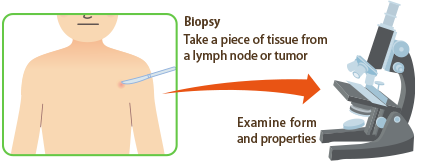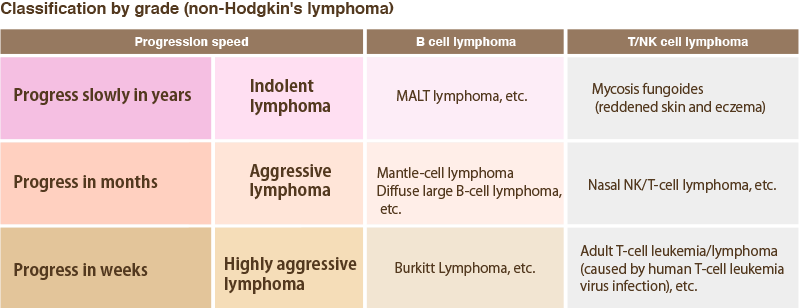The story of malignant lymphoma
1. What is malignant lymphoma?
Malignant lymphoma is a disease in which lymphocytes, a type of white blood cell, become cancerous (tumor) and form lumps (masses) in lymph nodes and organs (extranodal organs: stomach, intestines, thyroid, spinal cord, lungs, liver, skin, eyes, etc.). Malignant lymphoma is the most common hematologic cancer, and it is said to occur in about 10 out of every 100,000 people in Japan each year. It is known that viral and bacterial infections, chronic inflammatory stimulation, etc. are involved as part of the cause, but the details are not well understood. In addition, there is no special prevention method, and it is said that it is not inherited in principle.

2. Symptoms of malignant lymphoma
Lymphoma is often a painless lump in areas with many lymph nodes, such as the neck, armpit, or groin. In addition, unexplained fever, weight loss, and excessive night sweats may be present and are of particular importance in the diagnosis. Symptoms vary depending on the site of occurrence and the degree of progression, and when the progression of the disease is slow, there are many cases where no symptoms are seen. In addition, lumps that form in the abdomen and chest press on organs such as blood vessels and the spinal cord, and symptoms such as airway obstruction, blood flow disturbance, and paralysis may appear.

3. Examination and diagnosis of malignant lymphoma
Tests for malignant lymphoma can be roughly divided into three types: (1) tests to determine the type of disease (type), (2) tests to determine the spread of the disease (stage), and (3) tests to check the general condition.
① Tests to determine the type of disease (disease type)
It is a test to diagnose malignant lymphoma and the type of malignant lymphoma. A part of the lymph node or tumor is surgically removed (biopsy) and the tissue is viewed under a microscope. The shape and properties of lymphoma cells are examined in detail to diagnose the disease type (pathological diagnosis). In addition to microscopic observation, genetic testing may also be performed.
In some cases, a test method (cytology) in which a swollen lymph node is pierced with a needle and aspirated with a syringe may be performed. Although this test may be able to diagnose malignant lymphoma, it cannot provide a definitive diagnosis of disease type. Therefore, pathological diagnosis by biopsy is performed except in special situations where there is no time to wait until treatment.

② Examination to check the spread of disease (disease stage)
A test to determine the size of the lesion and how far it has spread. How far the disease has progressed is very important because it affects the treatment effect and prognosis.
- Chest x-ray
This is a general X-ray examination. - Ultrasound (echo) inspection
Ultrasound echoes in the body are used to examine the size and distribution of tumors. - CT examination, MRI examination
CT scans use x-rays and MRI scans use magnets to visualize the inside of the body and determine the size and extent of lesions. - Bone marrow examination
Bone marrow aspiration, in which a needle is inserted into the hip bone called the ilium to aspirate the bone marrow fluid, or bone marrow biopsy, in which a small amount of bone marrow tissue is collected, is used to examine the cells in the bone marrow. - Gastrointestinal endoscopy
An endoscope is used to check for lesions inside the stomach and to collect tissues. If necessary, a colonoscopy will also be performed. - PET examination, gallium scintigraphy
This is a test that detects cancer cells throughout the body by injecting a drug containing a radioactive substance and photographing the distribution of its uptake. Today, PET scans are more frequently performed because they are more useful. - Cerebrospinal fluid test A thin needle is inserted between the lumbar vertebrae to collect the cerebrospinal fluid in the spinal canal. It is done when lymphoma cells are suspected to have spread to the brain or spinal cord.
③ Examination to check general condition
To assess the general condition, tests are performed to determine the function of the heart, lungs, liver, and kidneys, as well as the presence or absence of causative viral infections and complications. Blood tests, urine tests, electrocardiography, echocardiography, blood gas analysis, etc. are performed.
Many examinations are performed, but these examinations are indispensable for determining an appropriate treatment policy and providing safe treatment.
4. Types of malignant lymphoma
The WHO (World Health Organization) classification, which is used worldwide, classifies malignant lymphoma into more than 50 types, depending on the properties of the cells and the site of origin. These are broadly classified into two categories: Hodgkin's lymphoma and non-Hodgkin's lymphoma. Non-Hodgkin's lymphoma accounts for about 90% of cases in Japan.
All malignant lymphomas other than Hodgkin's lymphoma are included in non-Hodgkin's lymphoma and are classified into histological types such as B-cell, T-cell, and NK-cell according to the types of lymphocytes that have become tumors.

5. Types of malignant lymphoma
Among non-Hodgkin's lymphomas, there are types that progress slowly over years (low grade) and types that progress over months or weeks and should be treated quickly (medium or high grade). Treatment methods differ depending on these types, so it is important to formulate a treatment strategy.

6. About the spread of disease
Since malignant lymphoma develops not only in lymph nodes but also in extranodal organs such as the stomach, intestines, and lungs, as well as in distant lymph nodes, it is necessary to perform a systemic examination to determine the degree of spread of the disease (stage). . We also check for systemic symptoms (B symptoms) associated with lymphoma. In addition to determining the histological type, it is also important to determine the disease stage in formulating a treatment policy.

7. Determination of treatment strategy
Treatment methods for malignant lymphoma mainly include radiotherapy and drug therapy (treatment with anticancer agents). These treatments differ depending on the patient's type of malignant lymphoma (histological type), spread (stage), disease type, and general condition. These factors are accurately identified and appropriate treatment methods are selected for each patient. It is also important for the patient to fully understand the treatment method for his/her own disease while consulting with the doctor, and to face the treatment together.
